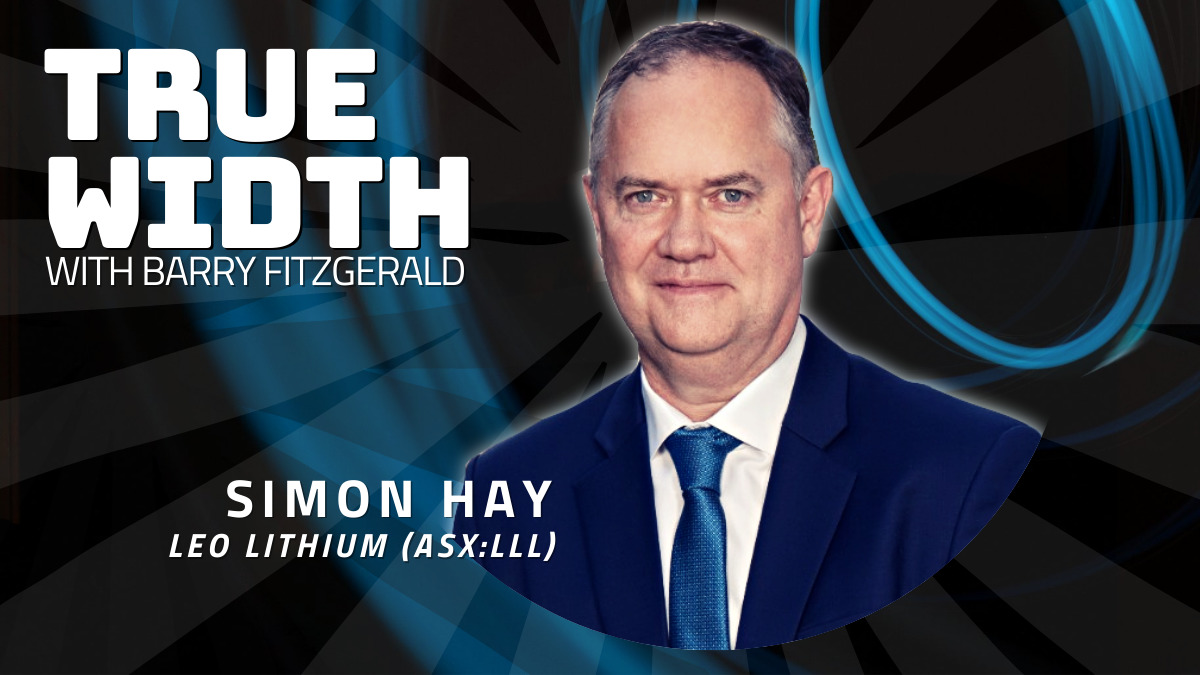True Width: This is the man Firefinch chose to lead Leo Lithium to Goulamina greatness

Special Report: In Barry Fitzgerald’s new regular column, True Width, he sits down with Australia’s leading resource and mining CEOs to discuss their current projects and plans for the future.
This week Barry sat down with Simon Hay, Managing Director of Firefinch (ASX:FFX) spin-off, Leo Lithium (ASX:LLL).
Last year’s mega-merger between Orocobre and Galaxy Resources to create the $5.8 billion ASX-listed lithium group Allkem – the fifth biggest in the world – posed a bit of a conundrum for Galaxy’s then chief executive officer Simon Hay.
Management of the merged Allkem swung to where its biggest assets are in Argentina but for Hay, a 30-year veteran of the resources space, moving to Buenos Aires was not on the agenda.
“I wanted to stay in Perth for family reasons, and I wanted to stay in lithium. And I was thinking there are not that many really good assets like Galaxy that had available positions,’’ Hay told Stockhead.
Still, no rest for the wickedly able – it wasn’t long before Hay was approached to lead the Mali-focussed Leo Lithium, the ASX’s new lithium powerhouse being demerged out of Perth-based Firefinch.
“The Leo opportunity popped up and it was too good to knock back. So I am really pleased to be here,’’ Hay said after getting his feet under the MD’s desk on January 10.
Everyone wants a piece of Goulamina
Leo and its 50:50 partner in the Goulamina lithium project in Mali, the Hong Kong-listed lithium group Ganfeng, have set out to establish the project as the world’s third biggest producer of spodumene concentrates, a lithium precursor.
Leo is being prepared for a listing on the ASX heading into the end of the March quarter, with its demerger from Firefinch intended to bring a sharper investor focus to Goulamina, as will be the case with Firefinch and its Morila gold mine in Mali.
Firefinch is busy returning the Morila to its former glory as “Morila the Gorilla,” a reference to its halcyon days under previous owner Randgold which merged with Barrick in 2018 to create the world’s biggest gold producer.
A new Godzilla at Morila
Under Firefinch, Morila is turning back the clock, expected to produce 100,000oz this year, with a further push to an annual rate of 200,000oz in 2024.
Hay explained the rationale for the Leo demerger: “Lithium and gold occupy very different parts of people’s investment plans. Lithium is a battery metal, it’s all growth. Gold is a currency, it’s an inflation hedge etc.’’
“By separating the two companies we will have pure gold investors looking at Firefinch with a lot more clarity. And it’s the same with the lithium side of things with Leo,’’ Hay said.
Firefinch/Leo and Ganfeng – the world’s biggest lithium metal producer and the third biggest lithium compounds producer with serious growth ambitions to boot – gave the go-ahead for the development of Goulamina early in January.
Billions: more than four of them
The final investment decision followed the release of an update to the October 2020 definitive feasibility study (DFS) which arrived at a pre-tax net present value for the project of $A4.1 billion, and a post-tax internal rate of return of 83%.
The capital cost for Stage 1 of the development (506,000 tonnes of spodumene concentrates annually) was estimated at $US255 million. Stage 2 which will increase annual production to 831,000 tonnes is estimated to cost an additional US$70 million.
The intention is to construct, commission and ramp up Stage 1 before approving the Stage 2 expansion and this is likely to be approximately 18 months after Stage 1 is completed.
Ganfeng’s buy-in to the previously 100% Firefinch-owned owned Goulamina has de-risked project financing for Firefinch/Leo.
Ganfeng has already provided $US130 million in funding as its acquisition cost for half of the joint venture.
That is being held in escrow and will be released after the Leo demerger is completed. And beyond that, Ganfeng is to provide either $A40 million in debt, or arrange up to $US120 million in third party debt.
Already going Ganfengbusters
“So in effect it is fully funded,’’ Hay said.
“However, when we do the demerger we are going to do an entitlement offer at the same and that will give Leo working capital, and take us well beyond fully funding Stage 1.”
Hay said the involvement of Ganfeng at Goulamina was a major factor for him in deciding to join Leo.
“With 100% of the product from Stage 1 being committed to Ganfeng, the offtake risk for the project has been completely removed. I see that as a real positive,’’ Hay said.
“They are very professional and have been nothing but supportive of the company in regard to funding, joint venture agreements, and metallurgical support on processing.’’
“They will help us with early procurement and we will use their network in China to leverage off that, hopefully to lower costs.’’
“It is a fantastic advantage,’’ Hay said.
Another terrific win is that Goulamina gets to draw on Ganfeng’s processing expertise.
“They are already testing the spodumene concentrate samples in their downstream processing facilities. And because we have only got one customer, we won’t have to re-qualify our concentrate across a range of different customers as other developers would have to do,’’ Hay said.
“They are a powerhouse in the industry so we are really pleased to have them aboard.’’
Gold trumps instability
Hay acknowledged that recent coups in Mali and elsewhere in West Africa meant developments in the region were not without challenges.
But he noted that Mali has long been a major gold producer and that the industry had not missed a beat.
He said the importance of the mining industry – lithium from Goulamina will be a first for the country – to the economy was well understood, and that the project was in the south-east away from recent flashpoints.
“And we’ve got a mature and experienced senior management team over there who are well connected, and well respected in government circles.’’
Hay noted that while Goulamina was already one of the world’s biggest lithium deposits, it remains to be fully drilled out.
“We’ve got sterilisation drilling happening and once that is completed in the next few months we are going to move the rig and do some infill drilling and some exploration drilling.’’
“We are confident we can continue to grow the resource. It is open at a number of locations. So we are going to test that further,’’ Hay said.
The project partners are currently working on the engaging of a civil engineering contractor and early civil works kicked off in February.
Hay: we’re making lithium while the sun shines
While 2021 was a boom year for the lithium market, with spodumene concentrate prices rising fivefold in response to lithium carbonate and hydroxide prices taking off, Hay expects there is more to come.
“I think the next decade for lithium is going to be enormous. There is going to be ups and downs as there always is, in every commodity cycle. But I think there is only minimal new supply coming online and demand is incredibly positive.’’
Firefinch is to retain up to 20% of the demerged Leo, with its shareholders to receive an in-specie distribution of shares in the new company at no cost.
This article was developed in collaboration with Firefinch, a Stockhead advertiser at the time of publishing.
This article does not constitute financial product advice. You should consider obtaining independent advice before making any financial decisions.
Related Topics

UNLOCK INSIGHTS
Discover the untold stories of emerging ASX stocks.
Daily news and expert analysis, it's free to subscribe.
By proceeding, you confirm you understand that we handle personal information in accordance with our Privacy Policy.








